Comparative Analysis: HIV Among Women in the US and Indonesia
VerifiedAdded on 2021/04/19
|8
|2312
|68
Essay
AI Summary
This essay provides a comparative analysis of HIV-related issues among women in the United States and Indonesia. It highlights the differing contexts and risk factors in each country, including mental illness, financial conditions, intimate partner violence in the US, and the prevalence of female sex workers in Indonesia. The essay explores key social determinants such as drug use, healthcare access, and government policies, revealing the challenges and disparities faced by women in both regions. It emphasizes the need for effective government policies, improved healthcare facilities, and awareness campaigns to address the HIV epidemic and reduce social stigma. The essay concludes by advocating for tailored interventions and cost-effective treatments to protect vulnerable populations, particularly women.
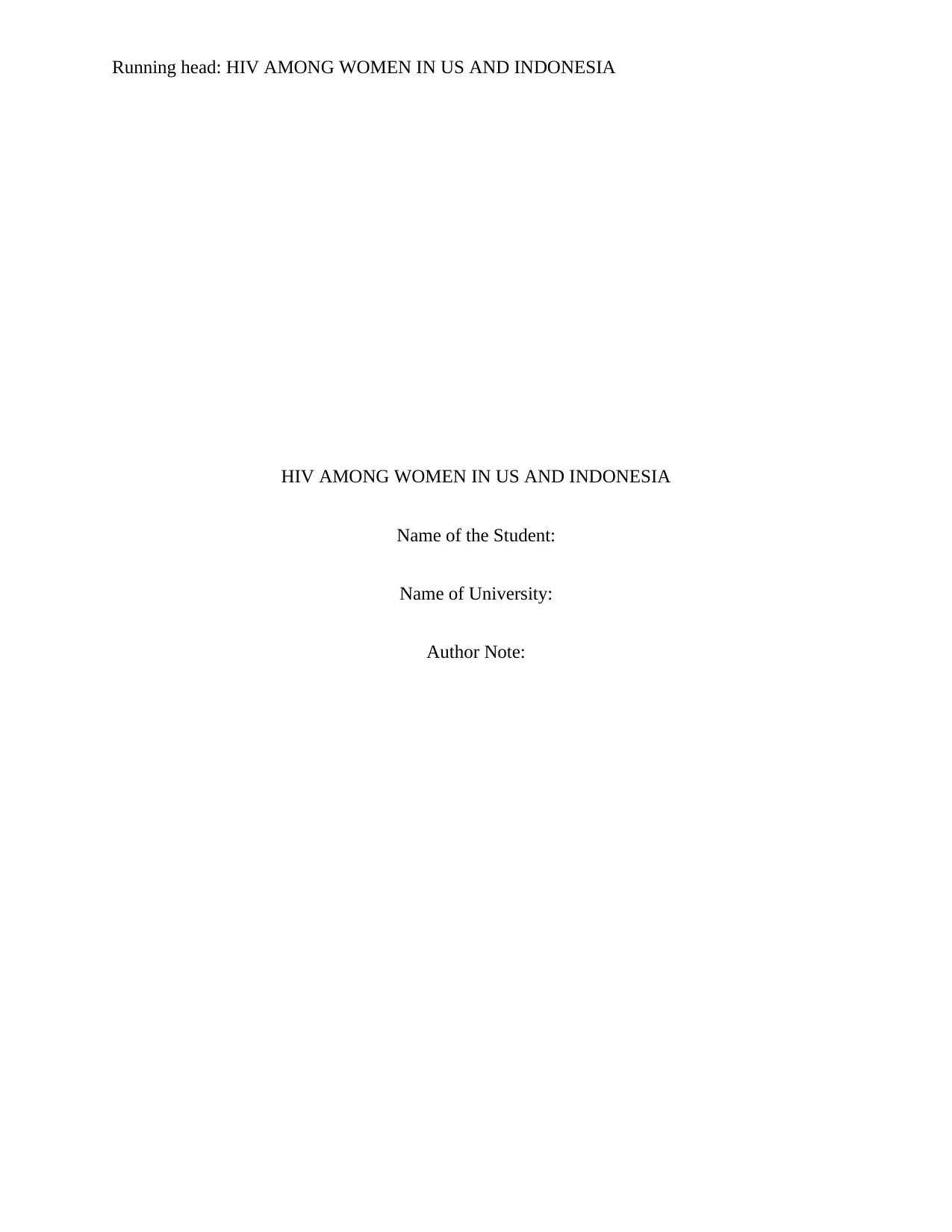
Running head: HIV AMONG WOMEN IN US AND INDONESIA
HIV AMONG WOMEN IN US AND INDONESIA
Name of the Student:
Name of University:
Author Note:
HIV AMONG WOMEN IN US AND INDONESIA
Name of the Student:
Name of University:
Author Note:
Paraphrase This Document
Need a fresh take? Get an instant paraphrase of this document with our AI Paraphraser
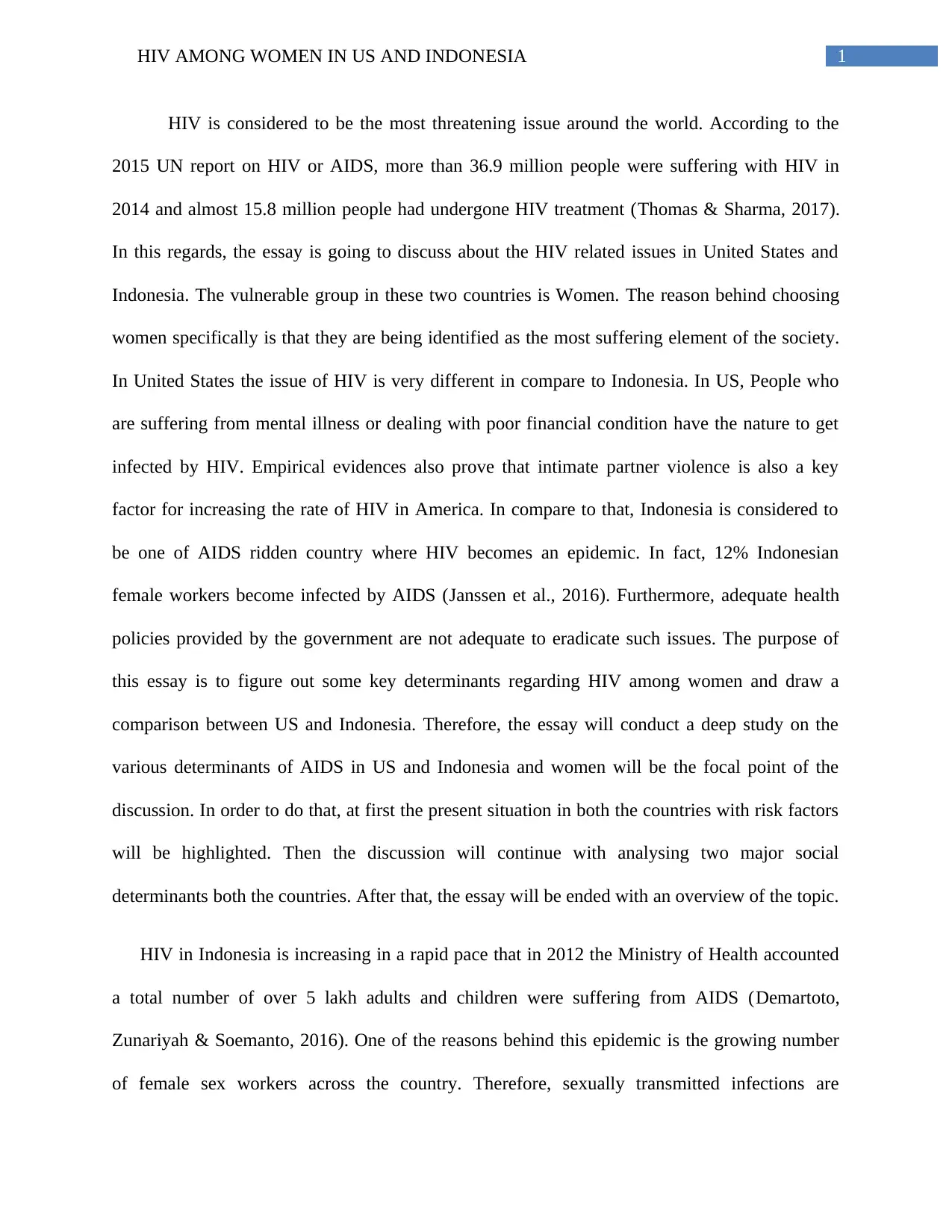
1HIV AMONG WOMEN IN US AND INDONESIA
HIV is considered to be the most threatening issue around the world. According to the
2015 UN report on HIV or AIDS, more than 36.9 million people were suffering with HIV in
2014 and almost 15.8 million people had undergone HIV treatment (Thomas & Sharma, 2017).
In this regards, the essay is going to discuss about the HIV related issues in United States and
Indonesia. The vulnerable group in these two countries is Women. The reason behind choosing
women specifically is that they are being identified as the most suffering element of the society.
In United States the issue of HIV is very different in compare to Indonesia. In US, People who
are suffering from mental illness or dealing with poor financial condition have the nature to get
infected by HIV. Empirical evidences also prove that intimate partner violence is also a key
factor for increasing the rate of HIV in America. In compare to that, Indonesia is considered to
be one of AIDS ridden country where HIV becomes an epidemic. In fact, 12% Indonesian
female workers become infected by AIDS (Janssen et al., 2016). Furthermore, adequate health
policies provided by the government are not adequate to eradicate such issues. The purpose of
this essay is to figure out some key determinants regarding HIV among women and draw a
comparison between US and Indonesia. Therefore, the essay will conduct a deep study on the
various determinants of AIDS in US and Indonesia and women will be the focal point of the
discussion. In order to do that, at first the present situation in both the countries with risk factors
will be highlighted. Then the discussion will continue with analysing two major social
determinants both the countries. After that, the essay will be ended with an overview of the topic.
HIV in Indonesia is increasing in a rapid pace that in 2012 the Ministry of Health accounted
a total number of over 5 lakh adults and children were suffering from AIDS (Demartoto,
Zunariyah & Soemanto, 2016). One of the reasons behind this epidemic is the growing number
of female sex workers across the country. Therefore, sexually transmitted infections are
HIV is considered to be the most threatening issue around the world. According to the
2015 UN report on HIV or AIDS, more than 36.9 million people were suffering with HIV in
2014 and almost 15.8 million people had undergone HIV treatment (Thomas & Sharma, 2017).
In this regards, the essay is going to discuss about the HIV related issues in United States and
Indonesia. The vulnerable group in these two countries is Women. The reason behind choosing
women specifically is that they are being identified as the most suffering element of the society.
In United States the issue of HIV is very different in compare to Indonesia. In US, People who
are suffering from mental illness or dealing with poor financial condition have the nature to get
infected by HIV. Empirical evidences also prove that intimate partner violence is also a key
factor for increasing the rate of HIV in America. In compare to that, Indonesia is considered to
be one of AIDS ridden country where HIV becomes an epidemic. In fact, 12% Indonesian
female workers become infected by AIDS (Janssen et al., 2016). Furthermore, adequate health
policies provided by the government are not adequate to eradicate such issues. The purpose of
this essay is to figure out some key determinants regarding HIV among women and draw a
comparison between US and Indonesia. Therefore, the essay will conduct a deep study on the
various determinants of AIDS in US and Indonesia and women will be the focal point of the
discussion. In order to do that, at first the present situation in both the countries with risk factors
will be highlighted. Then the discussion will continue with analysing two major social
determinants both the countries. After that, the essay will be ended with an overview of the topic.
HIV in Indonesia is increasing in a rapid pace that in 2012 the Ministry of Health accounted
a total number of over 5 lakh adults and children were suffering from AIDS (Demartoto,
Zunariyah & Soemanto, 2016). One of the reasons behind this epidemic is the growing number
of female sex workers across the country. Therefore, sexually transmitted infections are
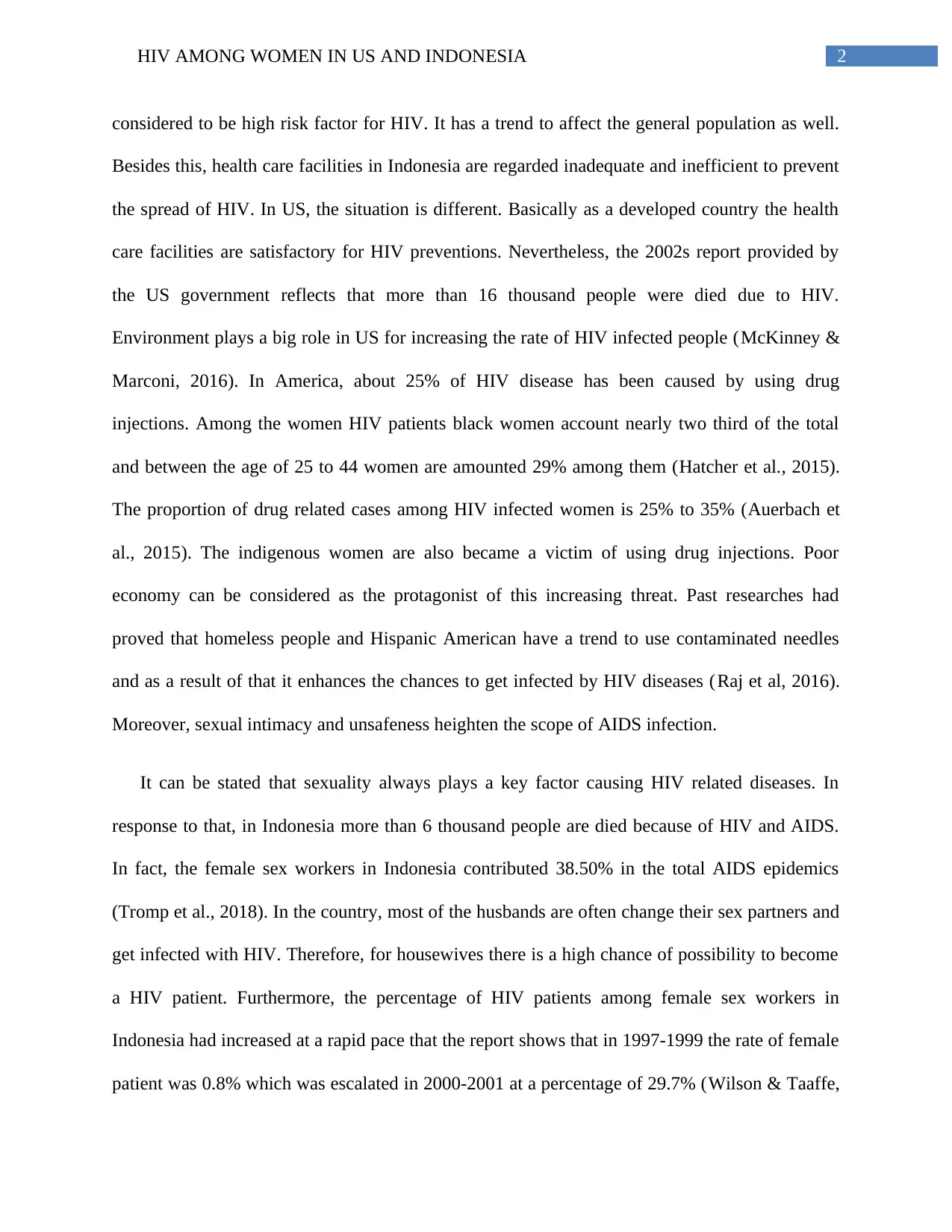
2HIV AMONG WOMEN IN US AND INDONESIA
considered to be high risk factor for HIV. It has a trend to affect the general population as well.
Besides this, health care facilities in Indonesia are regarded inadequate and inefficient to prevent
the spread of HIV. In US, the situation is different. Basically as a developed country the health
care facilities are satisfactory for HIV preventions. Nevertheless, the 2002s report provided by
the US government reflects that more than 16 thousand people were died due to HIV.
Environment plays a big role in US for increasing the rate of HIV infected people (McKinney &
Marconi, 2016). In America, about 25% of HIV disease has been caused by using drug
injections. Among the women HIV patients black women account nearly two third of the total
and between the age of 25 to 44 women are amounted 29% among them (Hatcher et al., 2015).
The proportion of drug related cases among HIV infected women is 25% to 35% (Auerbach et
al., 2015). The indigenous women are also became a victim of using drug injections. Poor
economy can be considered as the protagonist of this increasing threat. Past researches had
proved that homeless people and Hispanic American have a trend to use contaminated needles
and as a result of that it enhances the chances to get infected by HIV diseases (Raj et al, 2016).
Moreover, sexual intimacy and unsafeness heighten the scope of AIDS infection.
It can be stated that sexuality always plays a key factor causing HIV related diseases. In
response to that, in Indonesia more than 6 thousand people are died because of HIV and AIDS.
In fact, the female sex workers in Indonesia contributed 38.50% in the total AIDS epidemics
(Tromp et al., 2018). In the country, most of the husbands are often change their sex partners and
get infected with HIV. Therefore, for housewives there is a high chance of possibility to become
a HIV patient. Furthermore, the percentage of HIV patients among female sex workers in
Indonesia had increased at a rapid pace that the report shows that in 1997-1999 the rate of female
patient was 0.8% which was escalated in 2000-2001 at a percentage of 29.7% (Wilson & Taaffe,
considered to be high risk factor for HIV. It has a trend to affect the general population as well.
Besides this, health care facilities in Indonesia are regarded inadequate and inefficient to prevent
the spread of HIV. In US, the situation is different. Basically as a developed country the health
care facilities are satisfactory for HIV preventions. Nevertheless, the 2002s report provided by
the US government reflects that more than 16 thousand people were died due to HIV.
Environment plays a big role in US for increasing the rate of HIV infected people (McKinney &
Marconi, 2016). In America, about 25% of HIV disease has been caused by using drug
injections. Among the women HIV patients black women account nearly two third of the total
and between the age of 25 to 44 women are amounted 29% among them (Hatcher et al., 2015).
The proportion of drug related cases among HIV infected women is 25% to 35% (Auerbach et
al., 2015). The indigenous women are also became a victim of using drug injections. Poor
economy can be considered as the protagonist of this increasing threat. Past researches had
proved that homeless people and Hispanic American have a trend to use contaminated needles
and as a result of that it enhances the chances to get infected by HIV diseases (Raj et al, 2016).
Moreover, sexual intimacy and unsafeness heighten the scope of AIDS infection.
It can be stated that sexuality always plays a key factor causing HIV related diseases. In
response to that, in Indonesia more than 6 thousand people are died because of HIV and AIDS.
In fact, the female sex workers in Indonesia contributed 38.50% in the total AIDS epidemics
(Tromp et al., 2018). In the country, most of the husbands are often change their sex partners and
get infected with HIV. Therefore, for housewives there is a high chance of possibility to become
a HIV patient. Furthermore, the percentage of HIV patients among female sex workers in
Indonesia had increased at a rapid pace that the report shows that in 1997-1999 the rate of female
patient was 0.8% which was escalated in 2000-2001 at a percentage of 29.7% (Wilson & Taaffe,
⊘ This is a preview!⊘
Do you want full access?
Subscribe today to unlock all pages.

Trusted by 1+ million students worldwide
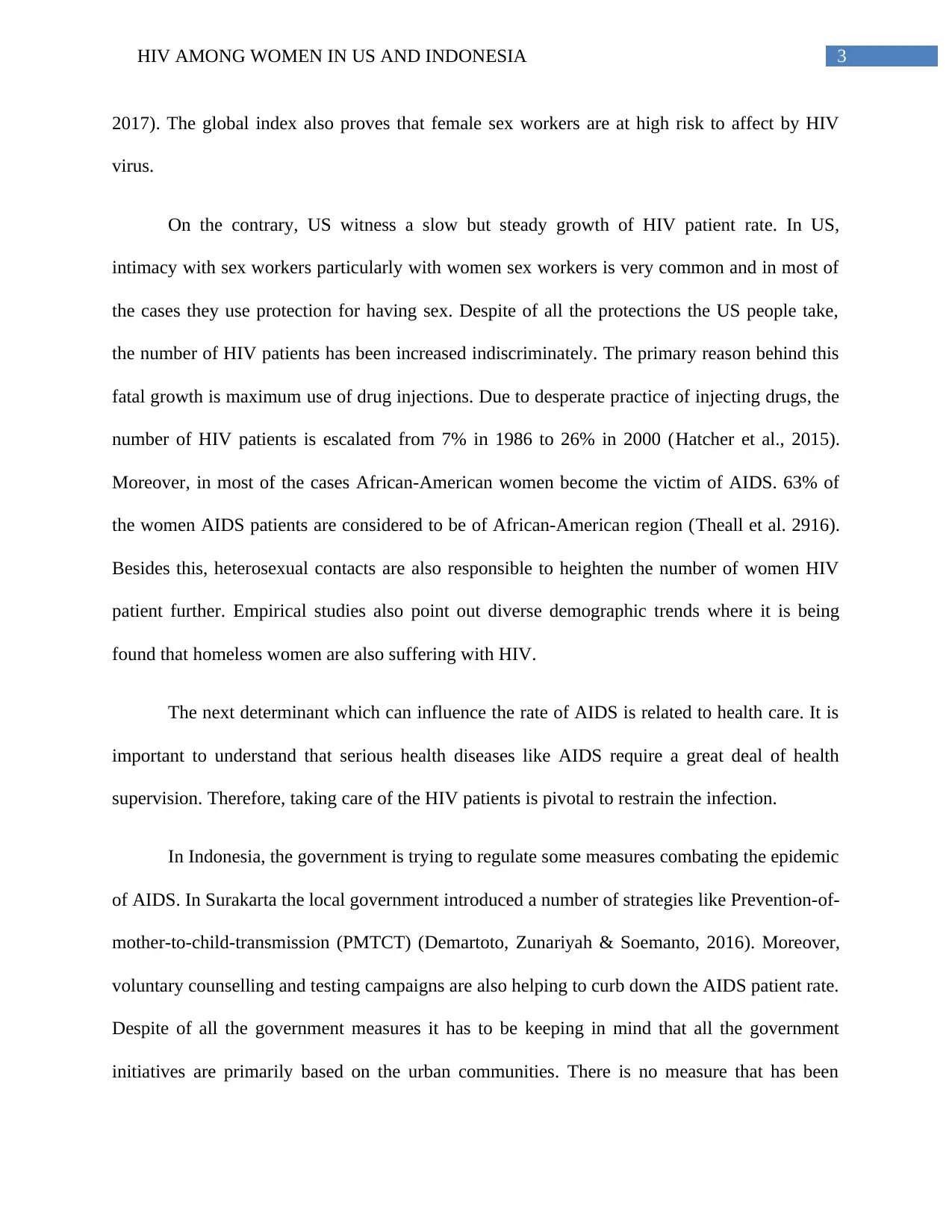
3HIV AMONG WOMEN IN US AND INDONESIA
2017). The global index also proves that female sex workers are at high risk to affect by HIV
virus.
On the contrary, US witness a slow but steady growth of HIV patient rate. In US,
intimacy with sex workers particularly with women sex workers is very common and in most of
the cases they use protection for having sex. Despite of all the protections the US people take,
the number of HIV patients has been increased indiscriminately. The primary reason behind this
fatal growth is maximum use of drug injections. Due to desperate practice of injecting drugs, the
number of HIV patients is escalated from 7% in 1986 to 26% in 2000 (Hatcher et al., 2015).
Moreover, in most of the cases African-American women become the victim of AIDS. 63% of
the women AIDS patients are considered to be of African-American region (Theall et al. 2916).
Besides this, heterosexual contacts are also responsible to heighten the number of women HIV
patient further. Empirical studies also point out diverse demographic trends where it is being
found that homeless women are also suffering with HIV.
The next determinant which can influence the rate of AIDS is related to health care. It is
important to understand that serious health diseases like AIDS require a great deal of health
supervision. Therefore, taking care of the HIV patients is pivotal to restrain the infection.
In Indonesia, the government is trying to regulate some measures combating the epidemic
of AIDS. In Surakarta the local government introduced a number of strategies like Prevention-of-
mother-to-child-transmission (PMTCT) (Demartoto, Zunariyah & Soemanto, 2016). Moreover,
voluntary counselling and testing campaigns are also helping to curb down the AIDS patient rate.
Despite of all the government measures it has to be keeping in mind that all the government
initiatives are primarily based on the urban communities. There is no measure that has been
2017). The global index also proves that female sex workers are at high risk to affect by HIV
virus.
On the contrary, US witness a slow but steady growth of HIV patient rate. In US,
intimacy with sex workers particularly with women sex workers is very common and in most of
the cases they use protection for having sex. Despite of all the protections the US people take,
the number of HIV patients has been increased indiscriminately. The primary reason behind this
fatal growth is maximum use of drug injections. Due to desperate practice of injecting drugs, the
number of HIV patients is escalated from 7% in 1986 to 26% in 2000 (Hatcher et al., 2015).
Moreover, in most of the cases African-American women become the victim of AIDS. 63% of
the women AIDS patients are considered to be of African-American region (Theall et al. 2916).
Besides this, heterosexual contacts are also responsible to heighten the number of women HIV
patient further. Empirical studies also point out diverse demographic trends where it is being
found that homeless women are also suffering with HIV.
The next determinant which can influence the rate of AIDS is related to health care. It is
important to understand that serious health diseases like AIDS require a great deal of health
supervision. Therefore, taking care of the HIV patients is pivotal to restrain the infection.
In Indonesia, the government is trying to regulate some measures combating the epidemic
of AIDS. In Surakarta the local government introduced a number of strategies like Prevention-of-
mother-to-child-transmission (PMTCT) (Demartoto, Zunariyah & Soemanto, 2016). Moreover,
voluntary counselling and testing campaigns are also helping to curb down the AIDS patient rate.
Despite of all the government measures it has to be keeping in mind that all the government
initiatives are primarily based on the urban communities. There is no measure that has been
Paraphrase This Document
Need a fresh take? Get an instant paraphrase of this document with our AI Paraphraser
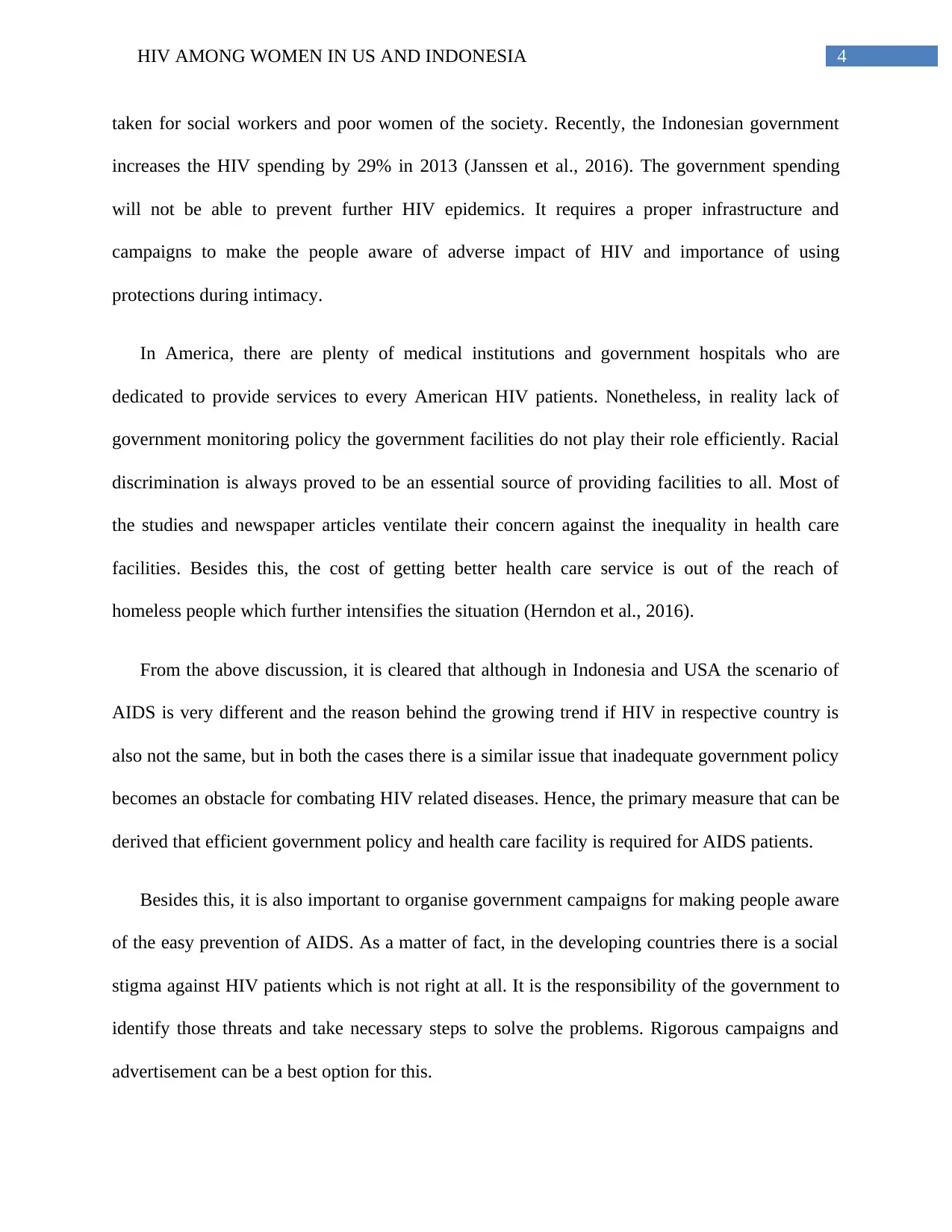
4HIV AMONG WOMEN IN US AND INDONESIA
taken for social workers and poor women of the society. Recently, the Indonesian government
increases the HIV spending by 29% in 2013 (Janssen et al., 2016). The government spending
will not be able to prevent further HIV epidemics. It requires a proper infrastructure and
campaigns to make the people aware of adverse impact of HIV and importance of using
protections during intimacy.
In America, there are plenty of medical institutions and government hospitals who are
dedicated to provide services to every American HIV patients. Nonetheless, in reality lack of
government monitoring policy the government facilities do not play their role efficiently. Racial
discrimination is always proved to be an essential source of providing facilities to all. Most of
the studies and newspaper articles ventilate their concern against the inequality in health care
facilities. Besides this, the cost of getting better health care service is out of the reach of
homeless people which further intensifies the situation (Herndon et al., 2016).
From the above discussion, it is cleared that although in Indonesia and USA the scenario of
AIDS is very different and the reason behind the growing trend if HIV in respective country is
also not the same, but in both the cases there is a similar issue that inadequate government policy
becomes an obstacle for combating HIV related diseases. Hence, the primary measure that can be
derived that efficient government policy and health care facility is required for AIDS patients.
Besides this, it is also important to organise government campaigns for making people aware
of the easy prevention of AIDS. As a matter of fact, in the developing countries there is a social
stigma against HIV patients which is not right at all. It is the responsibility of the government to
identify those threats and take necessary steps to solve the problems. Rigorous campaigns and
advertisement can be a best option for this.
taken for social workers and poor women of the society. Recently, the Indonesian government
increases the HIV spending by 29% in 2013 (Janssen et al., 2016). The government spending
will not be able to prevent further HIV epidemics. It requires a proper infrastructure and
campaigns to make the people aware of adverse impact of HIV and importance of using
protections during intimacy.
In America, there are plenty of medical institutions and government hospitals who are
dedicated to provide services to every American HIV patients. Nonetheless, in reality lack of
government monitoring policy the government facilities do not play their role efficiently. Racial
discrimination is always proved to be an essential source of providing facilities to all. Most of
the studies and newspaper articles ventilate their concern against the inequality in health care
facilities. Besides this, the cost of getting better health care service is out of the reach of
homeless people which further intensifies the situation (Herndon et al., 2016).
From the above discussion, it is cleared that although in Indonesia and USA the scenario of
AIDS is very different and the reason behind the growing trend if HIV in respective country is
also not the same, but in both the cases there is a similar issue that inadequate government policy
becomes an obstacle for combating HIV related diseases. Hence, the primary measure that can be
derived that efficient government policy and health care facility is required for AIDS patients.
Besides this, it is also important to organise government campaigns for making people aware
of the easy prevention of AIDS. As a matter of fact, in the developing countries there is a social
stigma against HIV patients which is not right at all. It is the responsibility of the government to
identify those threats and take necessary steps to solve the problems. Rigorous campaigns and
advertisement can be a best option for this.
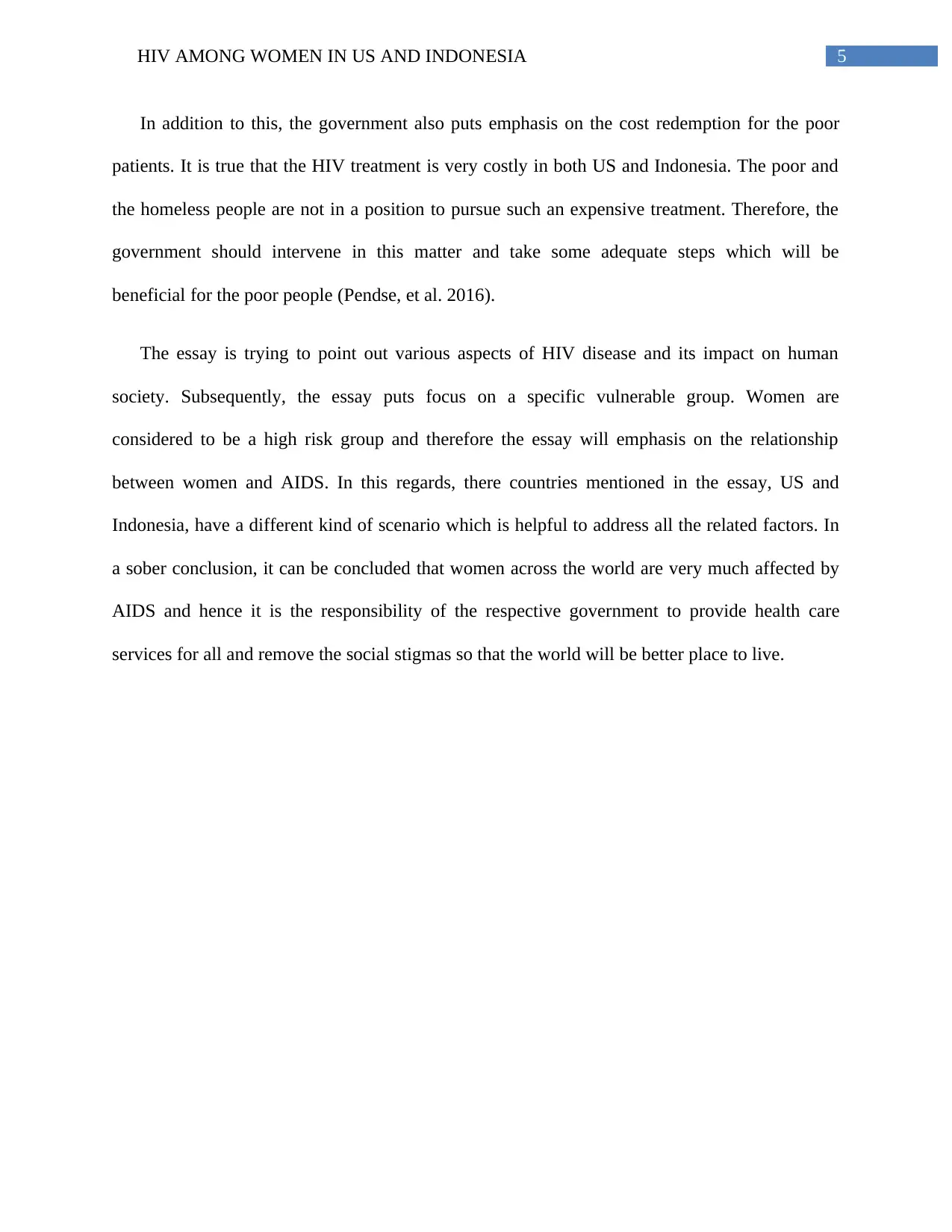
5HIV AMONG WOMEN IN US AND INDONESIA
In addition to this, the government also puts emphasis on the cost redemption for the poor
patients. It is true that the HIV treatment is very costly in both US and Indonesia. The poor and
the homeless people are not in a position to pursue such an expensive treatment. Therefore, the
government should intervene in this matter and take some adequate steps which will be
beneficial for the poor people (Pendse, et al. 2016).
The essay is trying to point out various aspects of HIV disease and its impact on human
society. Subsequently, the essay puts focus on a specific vulnerable group. Women are
considered to be a high risk group and therefore the essay will emphasis on the relationship
between women and AIDS. In this regards, there countries mentioned in the essay, US and
Indonesia, have a different kind of scenario which is helpful to address all the related factors. In
a sober conclusion, it can be concluded that women across the world are very much affected by
AIDS and hence it is the responsibility of the respective government to provide health care
services for all and remove the social stigmas so that the world will be better place to live.
In addition to this, the government also puts emphasis on the cost redemption for the poor
patients. It is true that the HIV treatment is very costly in both US and Indonesia. The poor and
the homeless people are not in a position to pursue such an expensive treatment. Therefore, the
government should intervene in this matter and take some adequate steps which will be
beneficial for the poor people (Pendse, et al. 2016).
The essay is trying to point out various aspects of HIV disease and its impact on human
society. Subsequently, the essay puts focus on a specific vulnerable group. Women are
considered to be a high risk group and therefore the essay will emphasis on the relationship
between women and AIDS. In this regards, there countries mentioned in the essay, US and
Indonesia, have a different kind of scenario which is helpful to address all the related factors. In
a sober conclusion, it can be concluded that women across the world are very much affected by
AIDS and hence it is the responsibility of the respective government to provide health care
services for all and remove the social stigmas so that the world will be better place to live.
⊘ This is a preview!⊘
Do you want full access?
Subscribe today to unlock all pages.

Trusted by 1+ million students worldwide
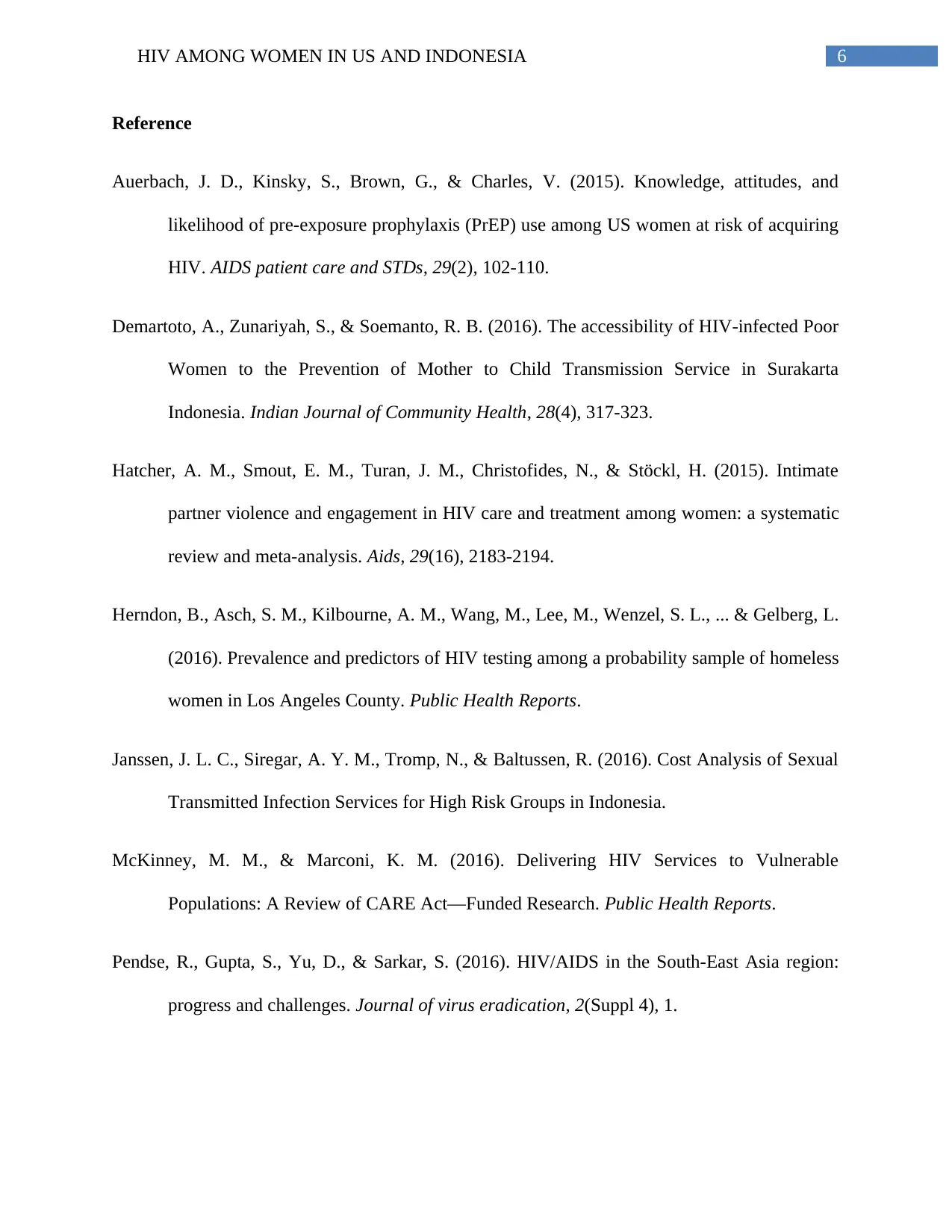
6HIV AMONG WOMEN IN US AND INDONESIA
Reference
Auerbach, J. D., Kinsky, S., Brown, G., & Charles, V. (2015). Knowledge, attitudes, and
likelihood of pre-exposure prophylaxis (PrEP) use among US women at risk of acquiring
HIV. AIDS patient care and STDs, 29(2), 102-110.
Demartoto, A., Zunariyah, S., & Soemanto, R. B. (2016). The accessibility of HIV-infected Poor
Women to the Prevention of Mother to Child Transmission Service in Surakarta
Indonesia. Indian Journal of Community Health, 28(4), 317-323.
Hatcher, A. M., Smout, E. M., Turan, J. M., Christofides, N., & Stöckl, H. (2015). Intimate
partner violence and engagement in HIV care and treatment among women: a systematic
review and meta-analysis. Aids, 29(16), 2183-2194.
Herndon, B., Asch, S. M., Kilbourne, A. M., Wang, M., Lee, M., Wenzel, S. L., ... & Gelberg, L.
(2016). Prevalence and predictors of HIV testing among a probability sample of homeless
women in Los Angeles County. Public Health Reports.
Janssen, J. L. C., Siregar, A. Y. M., Tromp, N., & Baltussen, R. (2016). Cost Analysis of Sexual
Transmitted Infection Services for High Risk Groups in Indonesia.
McKinney, M. M., & Marconi, K. M. (2016). Delivering HIV Services to Vulnerable
Populations: A Review of CARE Act—Funded Research. Public Health Reports.
Pendse, R., Gupta, S., Yu, D., & Sarkar, S. (2016). HIV/AIDS in the South-East Asia region:
progress and challenges. Journal of virus eradication, 2(Suppl 4), 1.
Reference
Auerbach, J. D., Kinsky, S., Brown, G., & Charles, V. (2015). Knowledge, attitudes, and
likelihood of pre-exposure prophylaxis (PrEP) use among US women at risk of acquiring
HIV. AIDS patient care and STDs, 29(2), 102-110.
Demartoto, A., Zunariyah, S., & Soemanto, R. B. (2016). The accessibility of HIV-infected Poor
Women to the Prevention of Mother to Child Transmission Service in Surakarta
Indonesia. Indian Journal of Community Health, 28(4), 317-323.
Hatcher, A. M., Smout, E. M., Turan, J. M., Christofides, N., & Stöckl, H. (2015). Intimate
partner violence and engagement in HIV care and treatment among women: a systematic
review and meta-analysis. Aids, 29(16), 2183-2194.
Herndon, B., Asch, S. M., Kilbourne, A. M., Wang, M., Lee, M., Wenzel, S. L., ... & Gelberg, L.
(2016). Prevalence and predictors of HIV testing among a probability sample of homeless
women in Los Angeles County. Public Health Reports.
Janssen, J. L. C., Siregar, A. Y. M., Tromp, N., & Baltussen, R. (2016). Cost Analysis of Sexual
Transmitted Infection Services for High Risk Groups in Indonesia.
McKinney, M. M., & Marconi, K. M. (2016). Delivering HIV Services to Vulnerable
Populations: A Review of CARE Act—Funded Research. Public Health Reports.
Pendse, R., Gupta, S., Yu, D., & Sarkar, S. (2016). HIV/AIDS in the South-East Asia region:
progress and challenges. Journal of virus eradication, 2(Suppl 4), 1.
Paraphrase This Document
Need a fresh take? Get an instant paraphrase of this document with our AI Paraphraser
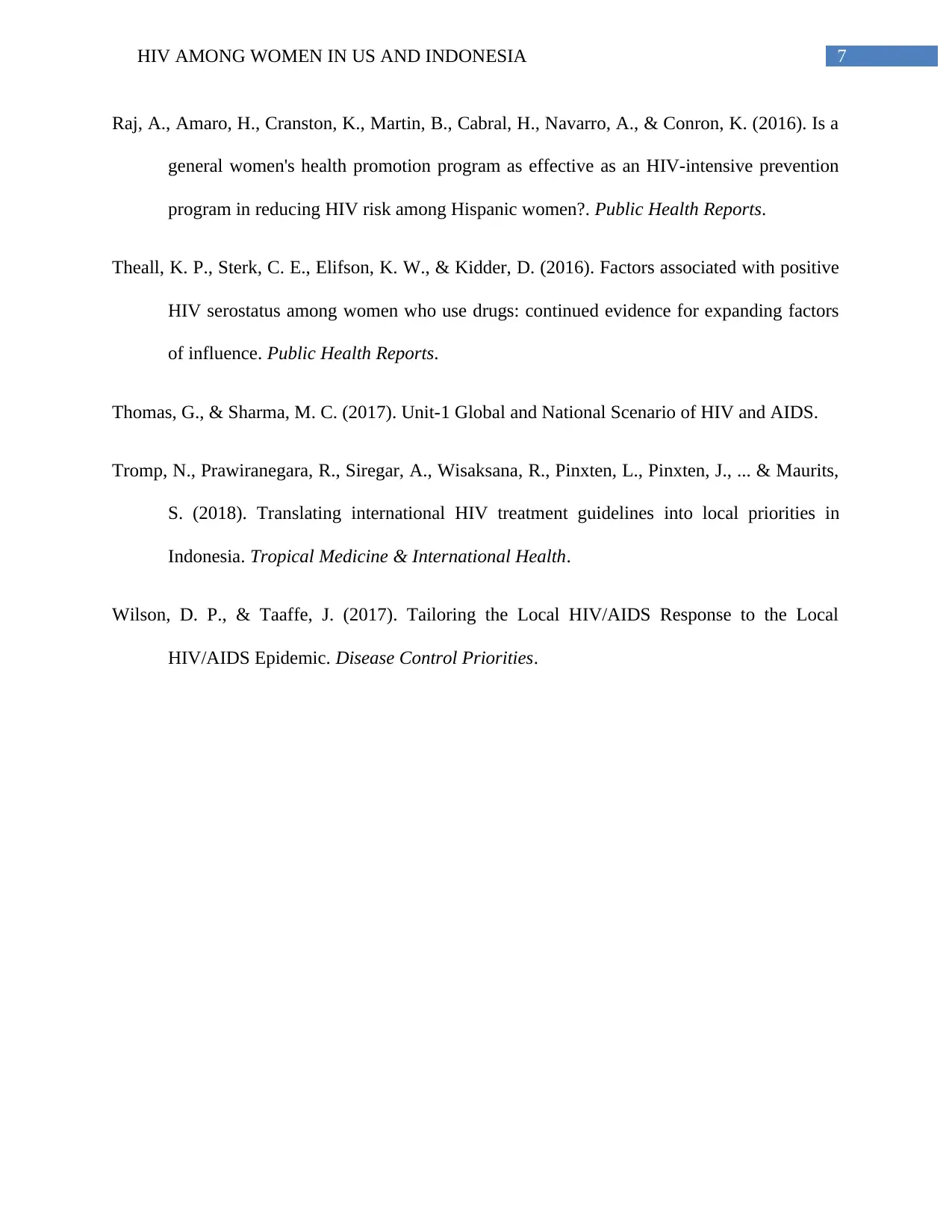
7HIV AMONG WOMEN IN US AND INDONESIA
Raj, A., Amaro, H., Cranston, K., Martin, B., Cabral, H., Navarro, A., & Conron, K. (2016). Is a
general women's health promotion program as effective as an HIV-intensive prevention
program in reducing HIV risk among Hispanic women?. Public Health Reports.
Theall, K. P., Sterk, C. E., Elifson, K. W., & Kidder, D. (2016). Factors associated with positive
HIV serostatus among women who use drugs: continued evidence for expanding factors
of influence. Public Health Reports.
Thomas, G., & Sharma, M. C. (2017). Unit-1 Global and National Scenario of HIV and AIDS.
Tromp, N., Prawiranegara, R., Siregar, A., Wisaksana, R., Pinxten, L., Pinxten, J., ... & Maurits,
S. (2018). Translating international HIV treatment guidelines into local priorities in
Indonesia. Tropical Medicine & International Health.
Wilson, D. P., & Taaffe, J. (2017). Tailoring the Local HIV/AIDS Response to the Local
HIV/AIDS Epidemic. Disease Control Priorities.
Raj, A., Amaro, H., Cranston, K., Martin, B., Cabral, H., Navarro, A., & Conron, K. (2016). Is a
general women's health promotion program as effective as an HIV-intensive prevention
program in reducing HIV risk among Hispanic women?. Public Health Reports.
Theall, K. P., Sterk, C. E., Elifson, K. W., & Kidder, D. (2016). Factors associated with positive
HIV serostatus among women who use drugs: continued evidence for expanding factors
of influence. Public Health Reports.
Thomas, G., & Sharma, M. C. (2017). Unit-1 Global and National Scenario of HIV and AIDS.
Tromp, N., Prawiranegara, R., Siregar, A., Wisaksana, R., Pinxten, L., Pinxten, J., ... & Maurits,
S. (2018). Translating international HIV treatment guidelines into local priorities in
Indonesia. Tropical Medicine & International Health.
Wilson, D. P., & Taaffe, J. (2017). Tailoring the Local HIV/AIDS Response to the Local
HIV/AIDS Epidemic. Disease Control Priorities.
1 out of 8
Related Documents
Your All-in-One AI-Powered Toolkit for Academic Success.
+13062052269
info@desklib.com
Available 24*7 on WhatsApp / Email
![[object Object]](/_next/static/media/star-bottom.7253800d.svg)
Unlock your academic potential
Copyright © 2020–2025 A2Z Services. All Rights Reserved. Developed and managed by ZUCOL.





